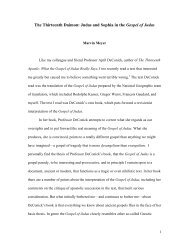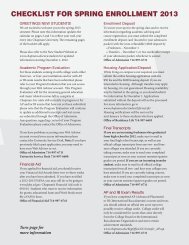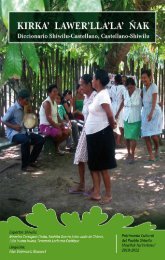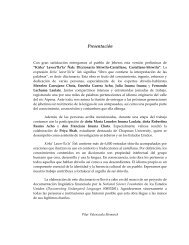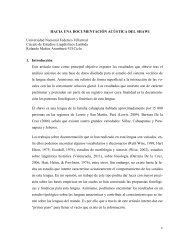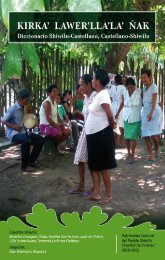“Surplus Humanity” and the Margins of Legality - Chapman University
“Surplus Humanity” and the Margins of Legality - Chapman University
“Surplus Humanity” and the Margins of Legality - Chapman University
You also want an ePaper? Increase the reach of your titles
YUMPU automatically turns print PDFs into web optimized ePapers that Google loves.
Do Not Delete 12/12/2010 7:34 PM<br />
8 <strong>Chapman</strong> Law Review [Vol. 14:1<br />
community <strong>and</strong> economy,‖ which ―has achieved a unique informal<br />
‗self-help‘ urban development over <strong>the</strong> years, without any<br />
external aid.‖ 48 While bereft <strong>of</strong> adequate housing, <strong>the</strong> slumdwellers<br />
have established ―close to 5000 industrial units,<br />
producing textiles, pottery <strong>and</strong> lea<strong>the</strong>r, <strong>and</strong> performing services<br />
like recycling, printing, <strong>and</strong> steel fabrication.‖ 49 The economic<br />
activity in Dharavi is ―decentralized, human scale, home-based,<br />
low-tech <strong>and</strong> labor-intensive . . . pedestrianized, communitycentric,<br />
<strong>and</strong> network-based . . . . A simplistic re-zoning <strong>and</strong><br />
segregating <strong>of</strong> <strong>the</strong>se activities . . . would certainly hurt this very<br />
unique urban form.‖ 50<br />
Polluting, toxic, <strong>and</strong> <strong>of</strong>ten illegal industries find Dharavi,<br />
where ―Darwin beats Keynes,‖ attractive. 51 Sweatshops<br />
pr<strong>of</strong>itably mine cheap labor under <strong>the</strong> radar <strong>of</strong> regulatory<br />
oversight. 52 Writers analogize Dante‘s Inferno to portray <strong>the</strong><br />
struggle for survival in slums where poverty, filth, crime, <strong>and</strong><br />
marginalization stalk <strong>the</strong> daily life <strong>of</strong> human beings. 53 Slumdwellers<br />
trade away physical security <strong>and</strong> public health for<br />
minimal shelter, <strong>and</strong> suffer environmental degradation including<br />
filthy water, polluted air, <strong>and</strong> toxic industrial waste. 54 They<br />
contend with <strong>the</strong> ―garbage dump syndrome,‖ 55 which is ―a<br />
concentration <strong>of</strong> toxic industrial activities such as metal plating,<br />
dyeing, rendering, tanning, battery recycling, casting, vehicle<br />
repair, [<strong>and</strong>] chemical manufacture.‖ 56 Dharavi, like most slums,<br />
is located in a disaster-vulnerable, ecologically fragile area, so<br />
that even a heavy rain can wipe out shelters. 57 An omnipresent<br />
48 Prakash M. Apte, Dharavi: India‘s Model Slum, PLANETIZEN (Sept. 29, 2008,<br />
5:00 AM), http://planetizen.com/node/35269.<br />
49 Id.<br />
50 Id.<br />
51 Hans Schenk, Urban Fringes in Asia: Markets versus Plans, in REALIGNING<br />
ACTORS IN AN URBANIZING WORLD: GOVERNANCE AND INSTITUTIONS FROM A<br />
DEVELOPMENT PERSPECTIVE 117, 131 (I. S. A. Baud & J. Post eds., 2002).<br />
52 SHARMA, supra note 37, at xxxv, 106.<br />
53 MICHAEL TAUSSIG, LAW IN A LAWLESS LAND: DIARY OF A LIMPIEZA IN COLUMBIA<br />
114–15 (2003); DAVIS, PLANET OF SLUMS, supra note 39, at 49.<br />
54 ELLEN BRENNAN, WOODROW WILSON INT‘L CTR. FOR SCHOLARS, POPULATION,<br />
URBANIZATION, ENVIRONMENT, AND SECURITY: A SUMMARY OF THE ISSUES 12–14 (1999).<br />
See also DAVIS, PLANET OF SLUMS, supra note 39, at 128–29.<br />
55 GITA DEWAN VERMA, SLUMMING INDIA: A CHRONICLE OF SLUMS AND THEIR<br />
SAVIOURS 16 (2002); DAVIS, PLANET OF SLUMS, supra note 39, at 129.<br />
56 DAVIS, PLANET OF SLUMS, supra note 39, at 129.<br />
57 See Mohamed Hamza & Roger Zetter, Structural Adjustment, Urban Systems, <strong>and</strong><br />
Disaster Vulnerability in Developing Countries, 15:4 CITIES 291, 291 (1998) (explaining<br />
that ―urban areas are not disaster prone by nature; ra<strong>the</strong>r . . . <strong>the</strong> structural processes<br />
which accelerate rapid urbanisation . . . increase <strong>the</strong> disaster vulnerability <strong>of</strong> <strong>the</strong> mass <strong>of</strong><br />
low-income urban dwellers‖). During <strong>the</strong> twentieth century, more than one hundred<br />
million homes were destroyed by earthquakes, mostly in slums, tenements districts, <strong>and</strong><br />
poor rural areas. DAVIS, PLANET OF SLUMS, supra note 39, at 126.




